U.S. Department of Transportation
Federal Highway Administration
1200 New Jersey Avenue, SE
Washington, DC 20590
202-366-4000
Federal Highway Administration Research and Technology
Coordinating, Developing, and Delivering Highway Transportation Innovations
|
Public Roads This magazine is an archived publication and may contain dated technical, contact, and link information. |
|
| Publication Number: Date: Spring 1996 |
Issue No:
Vol. 59 No. 4
Date: Spring 1996 |
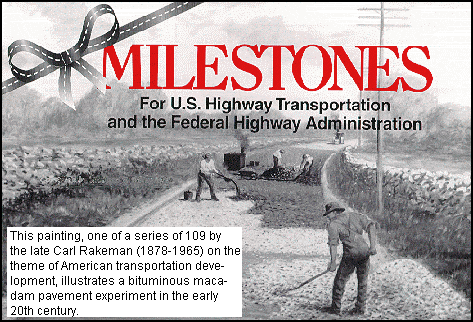
In Chicago, more than 1,000 attend organizational meeting of National League for Good Roads, designed to lobby for national road legislation. General Roy Stone elected general vice president and acting secretary.
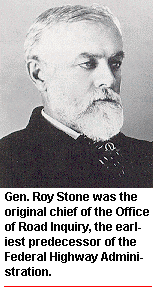
1893
Office of Road Inquiry under General Stone is established in Department of Agriculture on Oct. 3, 1893, with a $10,000 annual budget.
1896
First experimental routes for rural free delivery of mail are established in West Virginia.
1897
First object lesson road constructed in New Jersey on theory: seeing is believing.
1898
Demonstration section of "steel road" constructed at Trans-Mississippi Exposition in Omaha, Neb.
1900
Agency's first involvement in international road community occurs at International Good Roads Congress, Port Huron, Mich. Laboratory for testing of road materials established under Logan Waller Page.
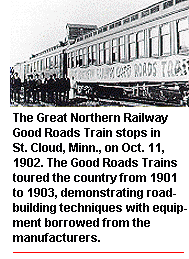
1901
The first Good Roads Train is jointly sponsored with National Good Roads Association and Illinois Central Railroad.
1903
Congress increases agency funding to $30,000, and Director Martin Dodge sets up first formal field structure, dividing the country into four divisions with a special agent in charge of each.
1904
Office of Public Roads Inquiries establishes a one-year engineer trainee program for selected college graduates.
1905
Office of Public Roads is established with a new director, Logan Page, and an annual budget of $50,000 and 10 employees.
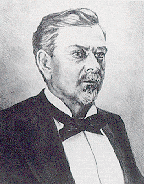
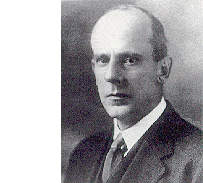
LEFT: In 1899, Martin Dodge, a former president of the Ohio State Highway Commission, was appointed director of the Office of Road Inquiry, which was renamed the Office of Public Road Inquiries. Dodge expanded the promotional and technical activities of the agency, established the first field structure, launched the first inventory of rural roads in the United States, and persuaded Congress to elevate the agency to permanent status within the Department of Agriculture.
RIGHT: Logan Waller Page became the first director of the newly created Office of Public Roads in 1905, and he served until 1919. As director, he began a series of investigations that won international acclaim, helped to found the American Association of State Highway Officials, and was instrumental in securing congressional approval of the Federal-Aid Highway Program in 1916.
1907
First national road inventory published (for 1904).
1908
Director Page heads U.S. delegation to First International Road Congress and helps create Permanent International Association of Road Congresses.
1910
Division of Highway Bridges and Culverts established (changed to Bridge Division following passage of Federal-Aid Road Act of 1916).
1911
Part-time special agents are appointed for each state to improve the collection and reporting of information.
1912
Experimental federal-aid program for post roads approved.
1914
Director Page joins with states in founding American Association of State Highway Officials (AASHO).
1916
Federal-Aid Road Act of 1916 establishes federal-aid highway program with a 50 percent-50 percent, federal-state matching share.
1917
Agency joins first organized U.S. Army truck convoy - Toledo, Ohio, to Baltimore, Md.

1918
The first road test begins at Bureau of Public Roadfs Experimental Farm in Arlington, Va., to measure impact forces of various wheel loads. In May, first issue of Public Roads magazine is published.
1919
Thomas H. MacDonald appointed to head Bureau of Public Roads (BPR); he leads agency for 34 years (from 1919 to 1953).
1920
MacDonald helps create Advisory Board on Highway Research, which became Highway Research Board in 1924 and Transportation Research Board in 1974.
1921
Federal-Aid Highway Act of 1921 adds system concept to the federal-aid highway program. Dr. L.I. Hewes opens Western Headquarters Office of BPR to administer federal-aid highway and direct federal highway construction programs in 11 western states (and Alaska and Hawaii).
1922
At BPR's request, U.S. Army produces "Pershing Map," first map of roads of prime importance in event of war.
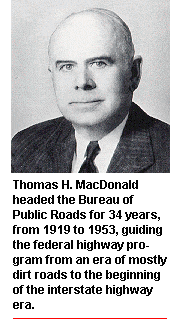
1923
Work of designating federal-aid system completed in accordance with 1921 act.
1924
First National Conference on Street and Highway Safety held in Washington, D.C.
1925
BPR joins with states to create U.S. numbered highway system for marking the main interstate highways.
1926
The secretaries of agriculture and the interior conclude cooperative agreement on road construction in parks.
1928
Federal-Aid Highway Amendment authorizes use of federal-aid funds for planting shade trees along highways.
1930
Dedication ceremonies take place upon completion of $2 million Zion-Mt. Carmel Highway in Zion National Park, Utah.
1932
Mount Vernon Memorial Parkway completed (now part of George Washington Memorial Parkway).
1933
Government suspends regular federal-aid authorizations and embarks on massive program of job-creating emergency public works.
1934
President Roosevelt transmits report to Congress on reconnaissance survey for proposed Inter-American Highway from Panama to the United States. Eastern Parks and Forests District created for forest and park work east of the Rocky Mountains.

1935
Construction begins on Blue Ridge Parkway near the North Carolina-Virginia border. With the closing of last gap in Nebraska, U.S. Route 30 becomes first paved transcontinental highway.
1936
Following a European tour, Director MacDonald addresses an American Automobile Association luncheon in Detroit on Germany's autobahn and on roads in England and France.
1937
First construction contract awarded for Natchez Trace Parkway (Madison County, Miss.).
1939
Report to Congress on "Toll Roads and Free Roads" contains the first formal concept of the Interstate Highway System.
1941
President Roosevelt appoints National Interregional Highway Committee, headed by MacDonald; its 1944 report refined the Interstate System concept.
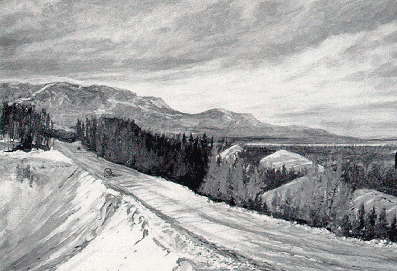
On Nov. 20, 1942, after the army engineers and civilian contractors worked on the construction of the Alaska Highway for seven months and 17 days, a crude but motorable road stretching 2,300 kilometers from Dawson Creek, British Columbia, to Big Delta, Alaska, was opened to truck traffic. The road was originally intended to connect and supply a chain of strategic military airfields and to provide an all-weather overland supply route to Alaska during World War II.
1942
BPR joins with U.S. Army Corps of Engineers to construct the "pioneer road" for the Alaska Highway.

1944
The Federal-Aid Highway Act of 1944 approves 64,000-kilometer "National System of Interstate Highways" and establishes a federal-aid secondary system of principal secondary and feeder roads.
1945
First edition of Highway Statistics is published.
1946
Division office established in Manila to begin improving war-damaged roads in the Philippine Islands.
1947
First 60,320 kilometers of Interstate System announced following coordination with states and Department of Defense.
1949
Legislation authorizes study and report on feasibility of a parkway along Mississippi River (Great River Road).
1950
Federal-Aid Highway Act of 1950 requires states to hold public hearings for projects bypassing cities or towns. First edition of Highway Capacity Manual is published.
1952
War Department Building (Pentagon) Road Network is completed (first contract in November 1941). Federal-Aid Highway Act of 1952 authorizes first funding specifically for Interstate System ($25 million).
1953
Comprehensive study of driver behavior on vertical and horizontal curves completed in cooperation with New York Department of Public Works.
1954
Federal-Aid Highway Act of 1954 included $175 million for Interstate System and created Secondary Road Plan.
1955
AASHO Road Test approved in agreement with BPR.
1956
President Eisenhower signs Federal-Aid Highway Act and Highway Revenue Act of 1956, creating the Highway Trust Fund and providing a mechanism for financing Interstate System.
1957
"The Chief," Thomas H. MacDonald, dies following a heart attack in College Station, Texas. A tribute says he "profoundly affected the course of modern life." AASHO plan for interstate highway numbering and signing approved.
1958
First National Conference on Highways and Urban Development held at Sagamore, Syracuse University.
1959
Members of Blatnik Committee, chaired by Rep. John A. Blatnik, are selected "to obtain solid facts about every phase of the Federal Highway program and after preliminary investigation hold open hearings" regarding allegations of fraud and corruption.
Chief Administrative Officers
Office of Road Inquiry to
Federal Highway Administration
1893-1996
| General Roy Stone (1893-1899) | Frank C. Turner (1969-1972) |
| Martin Dodge (1899-1905) | Norbert Tiemann (1973-1977) |
| Logan Waller Page (1905-1918) | William M. Cox (1977-1978) |
| Thomas H. MacDonald (1919-1953) | Karl S. Bowers (1978-1980) |
| Francis V. du Pont (1953-1955) | John S. Hassell Jr. (1980-1981) |
| Charles D. (Cap) Curtiss (1956) | Ray A. Barnhart (1981-1987) |
| John A. Volpe (1956-1957) | Robert E. Farris (1988-1989) |
| Bertram D. Tallamy (1957-1961) | Thomas D. Larson (1989-1993) |
| Rex Whitton (1961-1966) | Rodney E. Slater (1993-present) |
| Lowell K. Bridwell (1967-1969) |